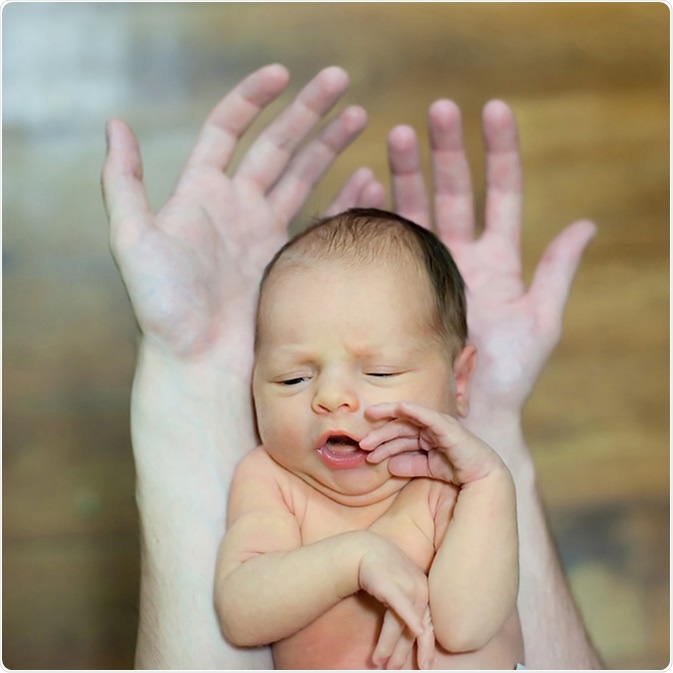Neonatal jaundice is a condition in which there is an abnormal elevation in serum bilirubin levels in a newborn infant.
Bilirubin is a yellow pigment, created during the breakdown of senescent red cells in the blood, which is cycled and eventually eliminated through the feces.
In some conditions its production is hiked or its elimination is significantly slowed, leading to its accumulation in the blood. This leads to yellow discoloration of the sclera and the skin, especially prominent in the palms and soles, though it also progresses downwards from the face.
Lethargy and failure to thrive may be prominent manifestations.

4 days old newborn baby laying on parents hands. Baby has neonatal jaundice. Image Credit: Alina R / Shutterstock
Causes
The immature liver system in neonates makes a slight degree of jaundice an expected phenomenon at this age.
The efficient elimination of this pigment which happened via the placenta no longer occurs following birth, leading to a temporary accumulation while the hepatic cells adjust to completely taking over the job.
Another cause is the increased breakdown of red cells for a short time following birth, which is termed physiological jaundice. This peaks between 2-4 days and subsides within a couple of weeks.
Breastfeeding is associated with jaundice, mostly during the first week while lactation is inadequate or not well established.
Another form is called breast milk jaundice and is due to significant interaction between certain substances present in breast milk and the liver metabolism of bilirubin. It appears after a week of life and peaks at around the second or third week. It may last for a month or so but bilirubin levels are rarely very high.
Pathological jaundice in the newborn always sets in within 24 hours. It may be caused by prematurity, conditions which predispose to hemolysis, rhesus incompatibility, cephalohematoma as occurs during ventouse extraction in some cases, or other difficult deliveries, neonatal infections and certain inborn enzyme defects.
Hepatic disease, medication, or hypoxia may also contribute or be responsible for this condition.
Newborn Jaundice
Diagnosis and Treatment
Jaundice in a newborn should be given due attention. The bilirubin levels in the blood should be measured. If abnormal, various other tests may be required such as Coomb’s test, reticulocyte count, complete blood count, infection markers, and others suggested by the infant’s symptoms. The trend is assessed to detect a rapidly rising bilirubin level early enough to prevent abnormally high levels from damaging the developing infant brain, a disease termed kernicterus.
In most cases the condition resolves itself, but in some cases urgent treatment is warranted:
- Rapid rise in bilirubin
- Preterm birth
- The baby’s age
- Such babies require to be fed plenty and often, with plenty of fluids, to lower the blood bilirubin and to ensure regular bowel movements which will help eliminate bilirubin.
If needed, the baby is placed under phototherapy lights on a regular basis for a couple of days. The most urgent treatment is an exchange transfusion to replace the baby’s blood. Intravenous immunoglobulin is also useful in severe jaundice. These measures help to prevent kernicterus with its associated complications such as cerebral palsy, deafness, and brain damage.
Frequent and adequate feeding will help reduce the risk of this condition. Rhesus incompatibility should also be ruled out. A review visit is always necessary to rule out this type of jaundice.
References
Further Reading
Last Updated: Jan 19, 2023